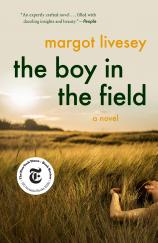The Boy in the Field
Review
The Boy in the Field
THE BOY IN THE FIELD is compelling in its simplicity and complexity. Each page is rich with understanding of how lives fit together and fall apart. Margot Livesey never pounds the reader with the same, obvious information or a wise authorly voice. She tells the seemingly simple story of a horrific and life-changing discovery by three young siblings --- Matthew, a senior in high school; 15-year-old Zoe, who has a gift for finding things; and Duncan, their artistic 13-year-old adopted brother.
Their father Hal, who is a blacksmith and owns the forge in their village, did not pick them up from school that afternoon as promised, so they decide to walk the few miles home. Zoe spots something unusual in one of the fields lined by a hedgerow of hawthorns. Soon they are kneeling by a young man who is bleeding and unconscious. He has been stabbed and beaten, and the red socks that Zoe believes she sees are actually blood stains on his legs. Duncan races back to the road and hails a passing automobile; the female driver returns to town and alerts the police.
"THE BOY IN THE FIELD is compelling in its simplicity and complexity. Each page is rich with understanding of how lives fit together and fall apart."
The siblings stay near the victim. Zoe touches his face, marveling at his beautiful eyes and hair. His eyes flutter, and he says one word. Matthew hears “Coward.” Zoe hears “Cowrie.” Duncan hears “Cowslip.” What each child hears is so distinctive and so obvious to him or her that they never discuss it. The ambulance arrives; it is only months later that they learn they each heard a different word.
Hugh Price, a detective from the town about 10 miles from Oxford, is assigned to the case, and he independently interviews each of the Lang children. Matthew, Zoe and Duncan honestly answer his questions. They are told not to discuss what happened with anyone so that the events remain pure and the effort to find the guilty party is not sullied. The disconcerting news is that only about half of such cases are solved.
The boy’s near-death defines the family and their conversations and actions. Matthew wants to aid the detective, and he secretly assists the victim’s older brother in searching for the assailant. Zoe feels empowered, and her changing awareness of her own abilities and strengths leads her to Oxford, where she finds an American. She becomes obsessed with him and finds him again and again. Duncan believes that he saw his birth mother standing in the garden the night they discovered the boy, and he feels that he must start the process of locating her.
After pointing out that Zoe has her mom’s full lips and Matthew has his dad’s hands, Duncan wants to find the someone who “has his hands.” He is meticulous and generous, finding the right words to ask his mom, dad, brother and sister if he may look for her. This search is achingly simple, and Livesey gives detail after detail as to how adoptive parents may tread this ground.
Each chapter is told from the point of view of one of the siblings in the months following the discovery. Each moment connects in some way to the boy in the field, yet each moves the child further into adulthood and awareness. Livesey introduces Baruch Spinoza and the power of single philosophical lines. She shows us Giorgio Morandi, an Italian painter, and how Duncan copies his art of painting bottles. A conversation with a costumed Oscar Wilde also appears, shortly after he wrote “The Importance of Being Earnest.” The author’s awareness of how children learn and apply what they know and understand to the world around them is beautifully done.
In the final chapter, “The Degree Show,” Matthew, Zoe and their parents attend Duncan’s degree show in London, eight-and-a-half years later. While some may feel that these last few pages are unnecessary, I appreciated the sense of closure. As truthful as the rest of the novel, Livesey’s concluding paragraph returns to the entire Lang family and the traumatic event. They have managed, and they chip away at the unfathomable.
Reviewed by Jane Krebs on August 14, 2020
The Boy in the Field
- Publication Date: July 27, 2021
- Genres: Fiction
- Paperback: 272 pages
- Publisher: Harper Perennial
- ISBN-10: 0062946404
- ISBN-13: 9780062946409




